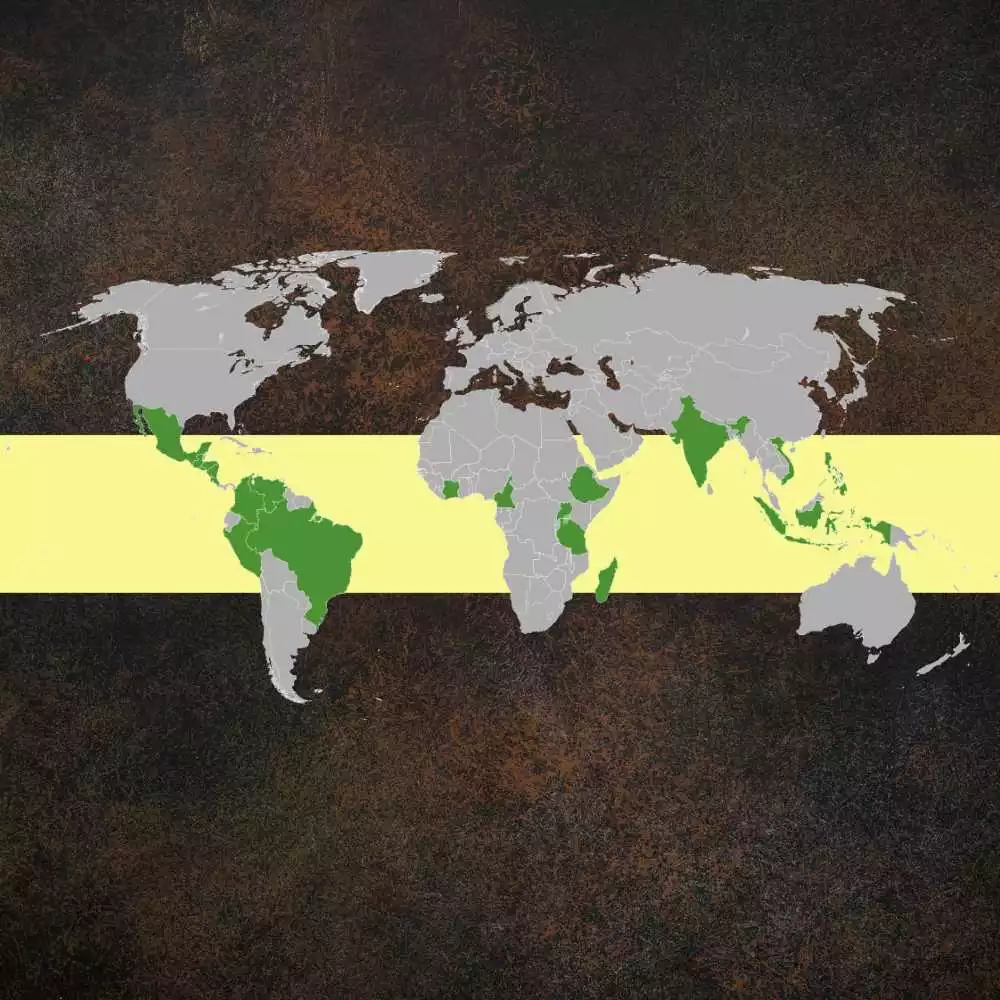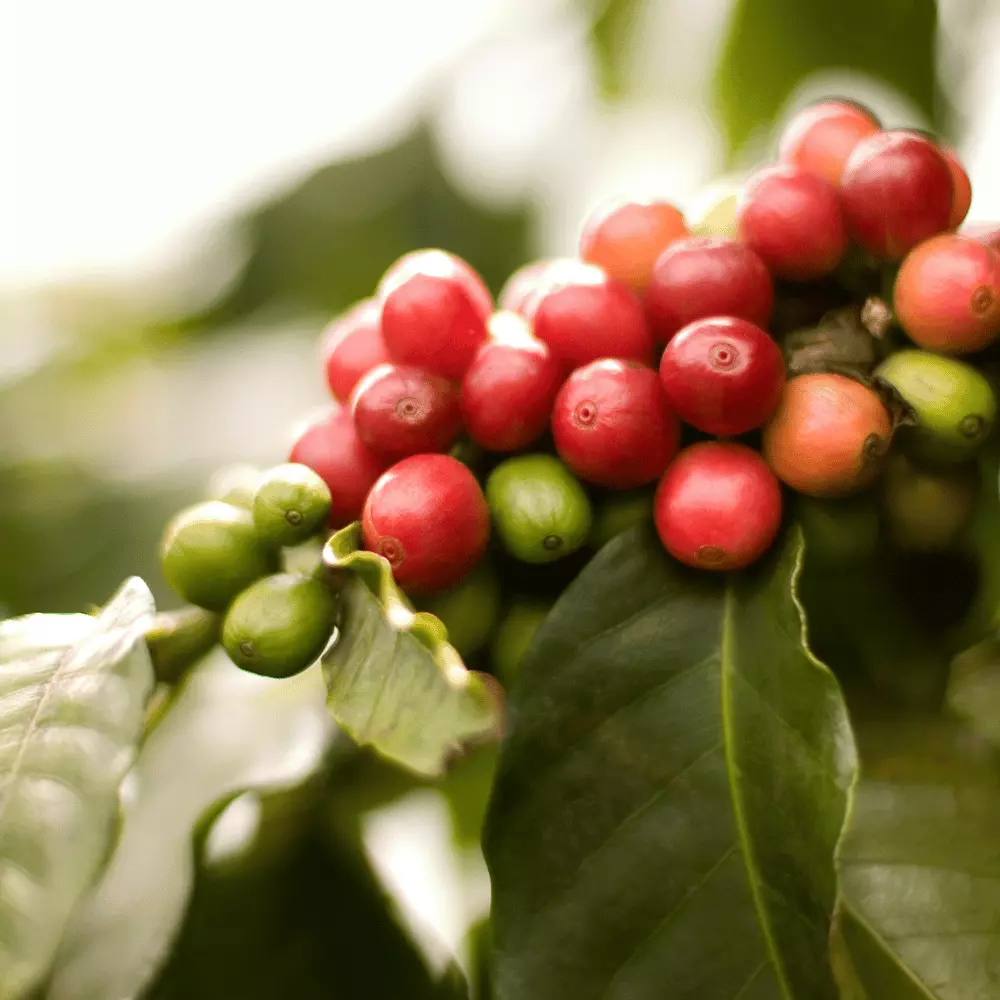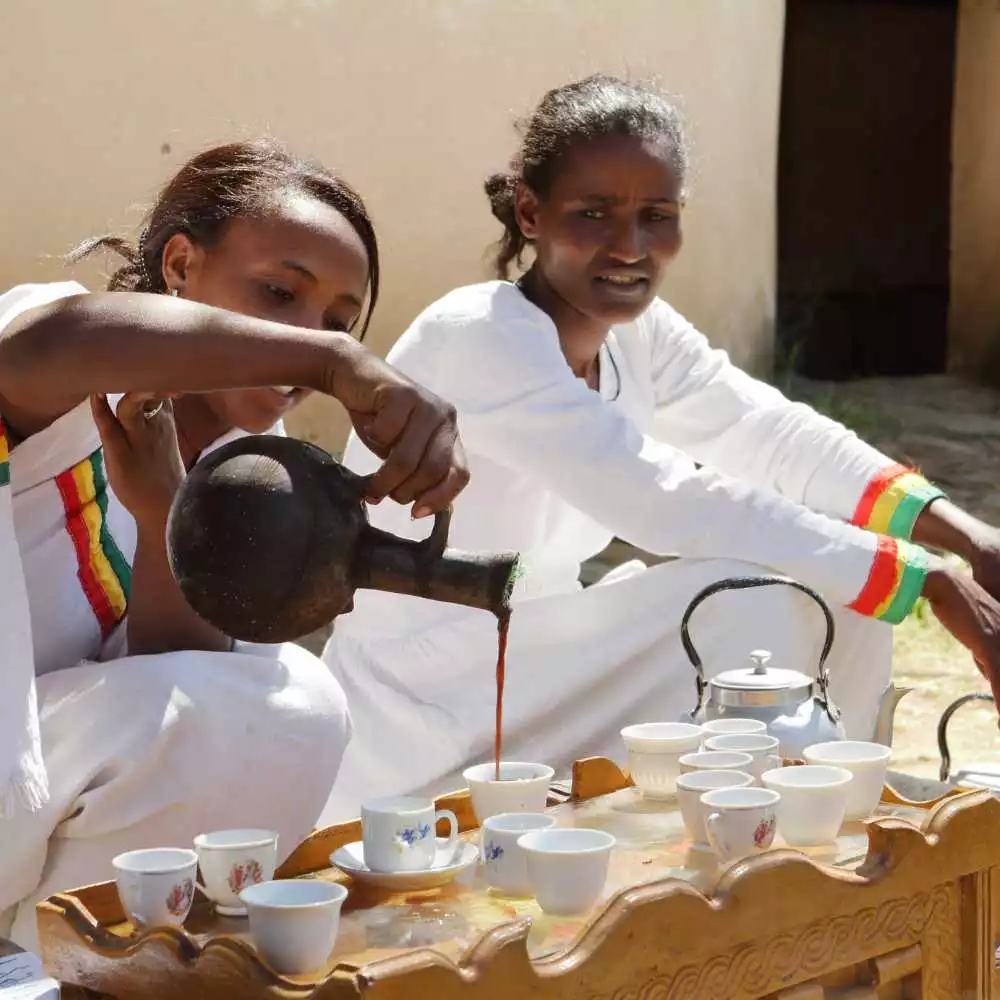For untold millions of individuals scattered throughout the expanse of the planet, the commencement of each day is inextricably linked to the ritual consumption of a steaming cup of coffee. The olfactory sensation produced by the rich and complex bouquet, coupled with the multifarious taste profile that is characteristic of this beloved beverage, is the culmination of centuries of agricultural refinement, innovative advancements, and the unwavering ardor of enthusiasts.
Nevertheless, one may be prompted to ponder the source of their preferred coffee bean. In point of fact, the origin of such beans is to be found within the Coffee Belt, an expansive band of tropical and subtropical regions that spans over seventy nations throughout the world. Within the confines of this enthralling sojourn through the Coffee Belt, we shall embark on an expedition to explore the historical, cultural, and environmental factors that have molded the most preeminent regions that cultivate coffee. Therefore, grasp your favored receptacle and accompany us as we disentangle the mysteries that lurk behind the beans that power our quotidian customs and unite individuals within the enchanting realm of coffee.
The Coffee Belt – Key Takeaway
- The Coffee Belt encompasses the world’s primary coffee-growing countries, spanning across Central and South America, Africa, the Middle East, and Asia, providing ideal conditions for diverse coffee cultivation.
- The flavor profiles of coffee beans are influenced by factors such as climate, altitude, and soil composition, resulting in a remarkable variety of flavors and aromas unique to each region within the Coffee Belt.
- Climate change poses significant challenges for coffee producers, including rising temperatures, increased risk of pests and diseases, and more frequent extreme weather events, prompting the need for adaptation and innovation in the industry.
- Coffee plays a vital cultural role within the Coffee Belt countries, with traditional rituals and customs that celebrate the beverage and foster connection, community, and shared experiences.
- Supporting sustainable coffee production and fair trade practices, such as purchasing certified coffee and advocating for environmentally friendly policies, helps protect the livelihoods of coffee farmers, their communities, and the ecosystems within the Coffee Belt.
A Brief History of Coffee and the Emergence of the Coffee Belt
The story of coffee is a fascinating one that spans centuries, continents, and cultures. From its humble beginnings in East Africa to the global powerhouse it is today, coffee has played a significant role in shaping the world’s economy, politics, and social dynamics. Let’s delve into the origins of coffee, its expansion into new territories, and the geographical and climatic conditions that have come to define the Coffee Belt.
Origins of Coffee: Ethiopia and the Arabian Peninsula
The journey of coffee begins in the ancient lands of Ethiopia, where the Coffea plant is native. Legend has it that the energizing properties of coffee beans were first discovered by a goat herder named Kaldi, who observed his goats becoming more active after eating the red berries from a specific tree. This discovery soon spread, and the people of the region began to experiment with the beans, eventually brewing a drink that resembles the coffee we know today. (1)

From Ethiopia, the cultivation and consumption of coffee spread to the Arabian Peninsula, particularly in present-day Yemen. Here, the fertile soils and perfect climate allowed coffee plants to thrive. In the 15th century, Sufi monasteries in Yemen began using coffee to stay awake during their long prayer sessions. The popularity of the beverage quickly grew, and coffee became a vital part of social life in the Arab world. (2)
Expansion of Coffee Cultivation to the New World
The booming coffee trade caught the attention of European explorers and traders in the 17th century. As European colonization expanded into the New World, so too did the desire to cultivate coffee. The Dutch were the first to bring coffee plants to their colonies in the East Indies, planting them in Java, now a part of Indonesia. (3) Soon after, the French and the British followed suit, introducing coffee to the Caribbean and the Americas.

By the 18th century, coffee had become a global commodity, with plantations established in Brazil, Colombia, Jamaica, and other regions with suitable climates for coffee cultivation. The expansion of coffee production led to the emergence of the Coffee Belt, which now stretches across the tropics and subtropics, connecting the Americas, Africa, and Asia.
Defining the Coffee Belt: Geography and Climate
The Coffee Belt, also known as the Bean Belt, is a region that encompasses the ideal conditions for growing coffee. Generally located between the Tropics of Cancer and Capricorn, the Bean Belt is characterized by its warm temperatures, abundant rainfall, and fertile soils. The combination of these factors allows for the cultivation of high-quality coffee beans with unique flavor profiles. (4)

Altitude plays a crucial role in coffee cultivation, with higher elevations often producing beans with more complex and nuanced flavors. The combination of geography and climate within these equatorial regions has given rise to a diverse range of coffee-growing areas, each with its distinct characteristics and flavor profiles. From the high-altitude plantations of Colombia to the volcanic soils of Hawaii, the Bean Belt is home to an incredible variety of beans that continue to entice and captivate coffee lovers worldwide.
Exploring the Coffee Belt: Notable Coffee-Producing Countries
The Coffee Belt is home to a diverse range of coffee-producing countries, each with its unique history, culture, and flavor profiles. As we journey through these equatorial regions, we’ll discover the distinctive characteristics of Colombian, Brazilian, and African coffees, showcasing the remarkable variety and richness that these regions have to offer.
The Alluring Aromas of Colombian Coffee
Colombia, nestled high in the Andes Mountains, is renowned for producing some of the world’s finest Arabica beans. The country’s diverse microclimates, high altitude, and fertile volcanic soils create the perfect conditions for growing exceptional coffee. Colombian coffee is often characterized by its bright acidity, medium body, and alluring aroma, featuring notes of citrus, chocolate, and nuts. (5)

Colombia’s coffee industry is dominated by small-scale farmers, who take great care in cultivating and processing their beans. This attention to detail, combined with the country’s ideal growing conditions, has cemented Colombia’s reputation as a premier coffee-producing nation.
The Bold Flavors of Brazilian Coffee
Brazil is the world’s largest coffee producer, accounting for roughly one-third of global coffee production. With its vast landmass and diverse climate, Brazil can cultivate a wide range of coffee varieties, including both Arabica and Robusta beans. Brazilian coffee is often characterized by its low acidity, full body, and bold flavors, with notes of chocolate, nuts, and caramel. (6)

The Brazilian coffee industry is known for its innovative production techniques and commitment to sustainability. In recent years, Brazil has made significant strides in improving the quality of its coffee, with an emphasis on specialty beans that showcase the unique flavors and characteristics of its diverse growing regions.
The Complex Nuances of African Coffees
Africa, the birthplace of coffee, continues to produce some of the most exquisite beans in the world. From the ancient coffee forests of Ethiopia to the slopes of Mount Kilimanjaro in Tanzania, African coffees are celebrated for their complex flavors, vibrant acidity, and rich aroma.
Ethiopian coffee, in particular, is highly sought after for its fruity and floral notes, often accompanied by bright, wine-like acidity. Kenya is another noteworthy coffee-producing nation, known for its bold, full-bodied beans with flavors of citrus, and tropical fruit. (7)

African coffee producers are renowned for their dedication to quality and tradition. Many still use centuries-old cultivation and processing techniques, resulting in beans that showcase the rich heritage and diverse flavors of this remarkable continent. As we continue to explore the Bean Belt, the enchanting nuances of African coffees remind us of the ancient roots and enduring allure of this beloved beverage.
The Impact of Climate Change on the Coffee Belt
As climate change continues to reshape our world, the Coffee Belt is facing significant challenges that threaten the future of coffee production. Rising temperatures, extreme weather events, and shifting weather patterns have far-reaching consequences for coffee growers and the delicate ecosystems that support them. In this section, we’ll explore the impact of climate change on the Bean Belt and how producers are adapting to these challenges through innovative strategies and practices.
Rising Temperatures and Coffee Production
Coffee plants are sensitive to temperature, with optimal growing conditions generally falling between 64-70°F (18-21°C) for Arabica beans. As global temperatures rise, coffee-growing regions are experiencing significant changes in their climate, with many areas becoming too hot for coffee cultivation.

Higher temperatures can lead to increased water stress for coffee plants, as well as increased susceptibility to pests and diseases, such as the devastating coffee leaf rust. (8) These challenges can result in reduced crop yields, lower quality beans, and, in some cases, the complete loss of coffee crops.
The Effects of Extreme Weather Events
Climate change is also contributing to more frequent and severe extreme weather events, such as droughts, floods, and storms. These events can have devastating consequences for coffee producers, particularly small-scale farmers who often lack the resources to recover from such disasters.

Droughts can lead to reduced coffee yields and increased pest infestations, while floods can cause soil erosion, damage to infrastructure, and the spread of waterborne diseases. In both cases, the quality and quantity of coffee beans are negatively affected, posing significant challenges to the livelihoods of coffee farmers and the global coffee supply.
Adaptation and Innovation: Strategies for Coffee Producers
In the face of these daunting challenges, coffee producers are developing innovative strategies to adapt to the changing climate and protect their livelihoods. Some of these strategies include:
- Diversification: Many coffee farmers are diversifying their crops, incorporating shade-grown coffee systems or intercropping with other plants to create more resilient agroecosystems. (9)
- Improved Varieties: Researchers and coffee growers are working together to develop new coffee varieties that are more resistant to pests, diseases, and temperature extremes. (10)
- Sustainable Farming Practices: Farmers are adopting sustainable practices, such as water conservation, soil management, and agroforestry, to mitigate the impacts of climate change on their farms.
- Early Warning Systems: Governments and organizations are investing in early warning systems to help farmers prepare for and respond to extreme weather events more effectively. (11)
- Education and Capacity Building: Providing resources and training for coffee farmers can help them better understand the impacts of climate change and implement effective adaptation strategies.
As the world grapples with the effects of climate change, coffee producers within the Bean Belt are demonstrating remarkable resilience and adaptability. By embracing innovation and sustainable practices, they are working to preserve the future of this cherished beverage and the communities that depend on it.
The Cultural Significance of Coffee in Coffee Belt Countries
Coffee is more than just a beverage; it’s a symbol of connection, a shared experience that transcends borders and cultures. Within the equatorial regions where coffee is most easily grown, its significance is deeply ingrained in the history, traditions, and economies of the countries that produce it. In this section, we’ll explore the unique coffee rituals and customs found around the world, the role of coffee in economic development, and the growing importance of sustainable coffee production and fair trade initiatives.

Coffee Rituals and Traditions Around the World
Throughout the Bean Belt, coffee is celebrated through a variety of rituals and customs that highlight its cultural significance. In Ethiopia, the birthplace of coffee, the traditional coffee ceremony is an integral part of social life. This elaborate process involves roasting, grinding, and brewing coffee beans in front of guests, then serving the resulting brew in small cups. The ceremony is a symbol of hospitality, friendship, and respect, and it is often accompanied by the burning of incense and the sharing of food.

In Turkey, coffee holds a special place in the national identity. To prepare Turkish coffee, finely ground coffee beans are boiled with water and sugar in a cezve, which is a special pot. It is then poured into small cups and served with a glass of water and a sweet treat. The thick, rich brew is a symbol of warmth and friendship, and it is often accompanied by lively conversation or fortune-telling using the coffee grounds left at the bottom of the cup.
These are just a few examples of the diverse and rich coffee rituals; each one highlights the unique ways in which coffee brings people together, fostering connection and community.
The Role of Coffee in Economic Development
Coffee plays a crucial role in the economies of many countries within the Bean Belt. For some nations, coffee exports are the primary source of foreign income, providing much-needed resources for development and growth. In countries like Colombia, Brazil, and Ethiopia, the coffee industry is responsible for generating millions of jobs, from farming and processing to transportation and marketing. (12)
Sustainable Coffee Production and Fair Trade Initiatives
As the global demand for coffee continues to grow, there is an increasing focus on sustainable coffee production and fair trade practices. These initiatives aim to protect the environment, promote social equity, and ensure a fair price for coffee farmers, many of whom face significant challenges in the face of volatile market prices and the impacts of climate change.
Sustainable coffee production involves implementing environmentally friendly practices, such as shade-grown coffee, organic farming, and water conservation, to minimize the ecological footprint of coffee cultivation. Fair trade initiatives, on the other hand, prioritize the welfare of coffee farmers and their communities by guaranteeing a minimum price for their beans, investing in community development projects, and promoting transparent and equitable supply chains.
As consumers become more conscious of the impact of their purchases, the demand for sustainably produced and ethically sourced coffee is on the rise. By supporting these initiatives, coffee lovers can help ensure a brighter future for the people and ecosystems.
Coffee Connoisseurship: Appreciating the Flavors of the Coffee Belt
As we journey through the Coffee Belt, we are presented with an incredible variety of beans. To truly appreciate the nuances of these diverse coffees, it’s essential to understand how to identify different flavor profiles, master brewing techniques, and discover the perfect pairings to elevate your coffee experience.
Identifying Flavor Profiles of Coffee from Different Regions

The flavor profile of a coffee is influenced by several factors, including the variety of the coffee plant, the altitude, and climate where it is grown, and the processing method used. By paying attention to these factors, coffee connoisseurs can learn to identify the distinctive characteristics of beans from different regions within the Bean Belt.
Brewing Techniques to Enhance Your Coffee Experience

The way you brew your coffee can significantly impact the flavors and aromas that you experience. Different brewing methods can accentuate or mute certain characteristics of the beans, allowing you to tailor your coffee experience to your personal preferences.
Some popular brewing methods include:
- Pour-over: This method, which involves pouring hot water over freshly ground coffee in a cone-shaped filter, is known for producing a clean, crisp cup with bright acidity and pronounced flavors.
- French press: When brewing French press, you steep coarsely ground coffee in hot water before pressing the plunger to separate the grounds from the brew. This method results in a rich, full-bodied cup with a velvety mouthfeel.
- Espresso: A high-pressure extraction method that produces a concentrated, intense shot of coffee with a creamy crema on top. Espresso forms the base for many popular coffee drinks, such as cappuccinos and lattes.
Experimenting with different brewing methods and techniques can help you uncover new dimensions of flavor in your coffee.
Coffee Pairings: Discovering the Perfect Combinations
Just as wine connoisseurs enjoy pairing their favorite vintages with complementary foods, coffee lovers can enhance their experience by discovering the perfect pairings for their beans. By considering the flavor profiles of both the coffee and the food, you can create harmonious combinations that elevate each component.

For example, a fruity Ethiopian coffee might pair beautifully with a tangy lemon dessert, while a full-bodied Brazilian coffee could complement a rich chocolate cake. Likewise, savory breakfast items like quiche or avocado toast can be matched with a coffee that highlights the contrasting flavors, such as a bright, acidic coffee from Colombia.
By exploring different coffee pairings, you can deepen your understanding and appreciation of the diverse flavors of the Bean Belt, transforming your daily cup of coffee into a truly immersive experience.
Conclusion
In conclusion, the Coffee Belt is a fascinating tapestry of cultures, flavors, and traditions, woven together by the shared passion for coffee. As we journey through this remarkable region, we discover the rich history and unique characteristics that define each coffee-producing country, from the ancient forests of Ethiopia to the vast plantations of Brazil. By appreciating the nuances of the diverse beans found within the Bean Belt, mastering brewing techniques, and exploring perfect pairings, we can deepen our understanding and love for this beloved beverage. As we confront the challenges posed by climate change and strive for sustainable and equitable production, our appreciation for these equatorial regions only grows stronger. So, let us raise our cups in a toast to the remarkable journey that each bean takes from farm to cup, and celebrate the enduring allure of the Bean Belt.
FAQ
How does climate influence the flavors of coffee from different regions?
Climate affects coffee flavors by influencing factors such as temperature, rainfall, altitude, and soil composition, resulting in diverse flavor profiles unique to each region.
What challenges are coffee producers facing due to climate change?
Climate change challenges for coffee producers include rising temperatures, increased pests and diseases, and more frequent extreme weather events, impacting crop yields and quality.
What are some traditional coffee rituals from countries within the Coffee Belt?
Traditional coffee rituals include Ethiopia's coffee ceremony, symbolizing hospitality and friendship, and Turkey's fortune-telling with coffee grounds left in the cup after drinking.
How can I support sustainable coffee production and fair trade practices?
Support sustainable coffee production and fair trade by purchasing certified coffee from organizations like Fair Trade International, Rainforest Alliance, or UTZ, and advocating for environmentally friendly policies.

























